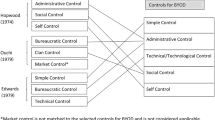Abstract
As firms increasingly rely on temporary clerical workers, previous control mechanisms centered in the workplace no longer are sufficient to maintain labor discipline and ensure production quality and uniformity. Through participant observation of four temporary help service firms and two placement sites, this case study reveals forms of control that differ from those in place at more commonly studied manufacturing enterprises. Temporary help service firms have developed a dualistic form of control that operates on two levels: (1) a decentralized level, whereby the temporary help service firm indirectly controls workers; and (2) a bureaucratic level, whereby the temporary help service firm rationalizes jobs in the organization's hierarchy by delimiting a set of tasks, competencies, and responsibilities.
Similar content being viewed by others
References
Allen, Sheila andCarol Wolkowitz 1987 Homeworking: Myths and Realities. London: MacMillan.
Appelbaum, Eileen 1987 “Restructuring work: Temporary, part-time and at-home employment.” In Heidi Hartmann (ed.), Computer Chips and Paper Clips: 268–310. Washington DC: National Academy Press.
Barker, Jane and Hazel Downing 1980 “Word processing and the transformation of the patriarchal relations of control in the office.” Capital and Class Spring: 64–99.
Beechey, Veronica andTeresa Perkins 1985 “Conceptualizing part-time work.” In Bryan Roberts, Ruth Finnegan, and Duncan Gallie (eds.), New Approaches to Economic Life: 246–263. Manchester: Manchester University Press.
Braverman, Harry 1974 Labor and Monopoly Capitalism. New York: Monthly Review Press.
Burawoy, Michael 1985 The Politics of Production. London: Verso Press.
Burke, Donald andRichard D. Leone 1976 Women Returning to Work and Their Interaction with a Temporary Help Service. Philadelphia, PA: Temple University Press.
Carey, Max andKim Hazelbaker 1986 “Employment growth in the temporary help industry.” Monthly Labor Review 109:37–44.
Christensen, Kathleen 1988 “Women's labor force attachment: Rise of contingent work.” In Department of Labor (ed.), Flexible Work Styles: 76–82. Washington DC: United States Department of Labor.
Christensen, Kathleen andMary Murphree 1988 “Introduction.” In Department of Labor (ed.), Flexible Work Styles: 1–11. Washington DC: United States Department of Labor.
Christopherson, Susan 1987 “The mobile work force.” High Flex Society Working Papers, Roosevelt Center for American Policy Studies, Washington, DC.
Collinson, David 1987 “‘Picking women’: The recruitment of temporary workers in the mail order industry.” Work, Employment and Society 3:371–387.
Costello, Cynthia 1987 “Working women's consciousness: Traditional or oppositional.” In Carol Groneman and Mary Beth Norton (eds.), To Toil the Livelong Day: America's Women at Work, 1780–1980: 284–302. Ithaca, NY: Cornell University Press.
Davies, Scott 1990 “Inserting gender into Burawoy's theory of the labor process.” Work, Employment and Society 4:391–406.
Edwards, Richard 1979 Contested Terrain: The Transformation of the Workplace in the Twentieth Century. New York: Basic Books.
Friedman, Andrew 1977 Industry and Labour: Class Struggle at Work and Monopoly Capitalism. London: Macmillan.
Game, Ann andRosemary Pringle 1984 Gender at Work. London: Pluto Press.
1974 “A profile of the temporary help industry and its workers.” Monthly Labor Review 95:44–49.
1975 “The management of peripheral employees.” Personnel Journal 54:482–486.
1984 “Preferences of temporary workers: Time, variety, and flexibility.” Monthly Labor Review 107:26–28.
Gottfried, Heidi andDavid Fasenfest 1984 “The role of gender in class formation: A case of female clerical workers.” Review of Radical Political Economics 16:89–104.
Hartmann, Heidi andJune Lapidus 1989 “Temporary work.” Working Paper No. 29, Institute for Women's Policy Research, Washington DC.
Hinrichs, Karl 1985 “Flexible working hours—How to match employees' preferences and enterprises interests.” Unpublished paper presented at the Conference on Critical Perspectives in Organizational Analysis, Baruch College.
Howe, Wayne 1986 “Temporary help workers: Who they are, what jobs they hold.” Monthly Labor Review 109:45–47.
Kanter, Rosabeth Moss 1977 Men and Women of the Corporation. New York: Basic Books.
Mangum, Gareth, Donald Mayall, andKristen Nelson 1985 “The temporary help industry: A response to the dual internal labor market.” Industrial and Labor Relations Review 38:599–611.
Nelson, Anne 1988 “Temporary help is becoming a permanent solution.” In The Department of Labor (ed.), Flexible Work Styles: 50–53. Washington DC: United States Department of Labor.
9 to 5 National Association of Working Women 1986 “Working at the margins: Part-time and temporary workers in the U.S.” Cleveland, OH: 9 to 5, National Association of Working Women.
Olesen, Virginia andFrances Katsuranis 1978 “Urban nomads: Women in temporary clerical services.” In Ann Stromberg and Shirley Harkess (eds.), Women Working: 316–338. Palo Alto, CA: Mayfield Publishers.
Pollock, Michael 1986 “The disposable employee in becoming a fact of corporate life.” Business Week Dec. 15: 52–56.
Pringle, Rosemary 1988 Secretaries Talk: Sexuality, Power and Work. London: Verso.
Thompson, Paul 1989 The Nature of Work: An Introduction to Debates on the Labor Process. New York: Humanities Press.
Tomaskovic-Devy, Donald and Barbara Risman 1989 “Organizational, managerial and employee constraints on the reorganization of work: The case of telecommuting.” Unpublished paper, North Carolina State.
Author information
Authors and Affiliations
Rights and permissions
About this article
Cite this article
Gottfried, H. Mechanisms of control in the temporary help service industry. Sociol Forum 6, 699–713 (1991). https://doi.org/10.1007/BF01114408
Issue Date:
DOI: https://doi.org/10.1007/BF01114408




